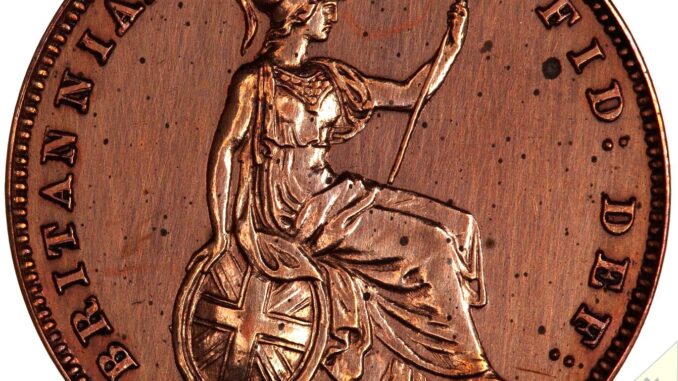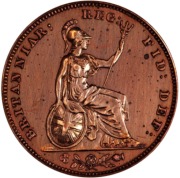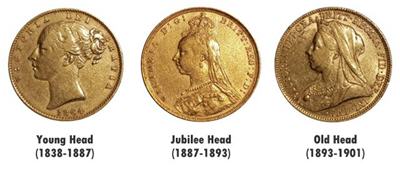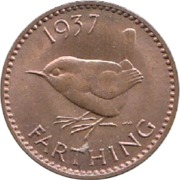
 The 1860 Farthings - Victoria (Copper) Proof
The 1860 Farthings - Victoria (Copper) ProofCopper farthings were used from 1838 until 1860 when they were replaced by Bronze farthings as bronze can give a better quality longer lasting coin. In 1860 both the copper and bronze farthings were issued. SCBC: 3950.
It's easy to tell the difference - the copper farthing (the one shown) has the date on the obverse; the bronze farthing has the date on the reverse. The bronze farthing is also smaller. The identification is important as the 1860 copper farthing is rare and many thousands of pounds more expensive.
The coin has a diameter of 22mm and a weight of 4.713g.
The Reverse shows Britannia facing right with trident and shield. Legend BRITANNIAR: REG: FID: DEF:. At the bottom in the exergue is a rose, thistle and shamrock intertwined representing the countries of Great Britain.
Edge is plain.
 The Obverse shows a portrait of Queen Victoria by William Wyon. His initials, 'W W' are on the truncation of the neck. Legend is VICTORIA DEI GRATIA with date below.
The Obverse shows a portrait of Queen Victoria by William Wyon. His initials, 'W W' are on the truncation of the neck. Legend is VICTORIA DEI GRATIA with date below.Image credit: Museums Victoria.
Mintage: Rare
Minted at The Royal Mint
More information (monarch, year, mint, country, category) can be found below coin listings.
Below are some coins currently being offered on eBay. As an eBay Partner, We may be compensated if you make a purchase.
List items on:
List items on:
Remember 1860 ?
Monarch is Queen Victoria. Prime Minister is Henry John Temple, 3rd Viscount Palmerston (Liberal). US President is James Buchanan (D-Pennsylvania). The first professional golf tournament is held at Prestwick, Scotland. First records of fish and chip shops in the UK. Charles Dickens's novel Great Expectations is published.
In the USA, the 1860 Census shows the population of the USA was 31,443,321, a 35.6% increase since 1850. Abraham Lincoln is selected as the U.S. presidential candidate for the Republican Party and in November becomes elected to be the 16th President and first Republican to hold the office. The Pony Express begins its first run from Saint Joseph, Missouri to Sacramento, California.
In the USA, the 1860 Census shows the population of the USA was 31,443,321, a 35.6% increase since 1850. Abraham Lincoln is selected as the U.S. presidential candidate for the Republican Party and in November becomes elected to be the 16th President and first Republican to hold the office. The Pony Express begins its first run from Saint Joseph, Missouri to Sacramento, California.
Victoria (1837-1901)
Victoria was Queen of the United Kingdom of Great Britain and Ireland from 20 June 1837 until her death. From 1 May 1876, she adopted the additional title of Empress of India. Victoria ruled for 64 years, a record only recently surpassed by Queen Elizabeth II.Victoria's parents were Prince Edward, Duke of Kent and Strathern, and Princess Victoria of Saxe-Coburg-Saalfeld. She married Albert of Saxe-Coburg and Gotha, who later became known as Prince Albert. Victoria had nine children, the eldest son succeeding her as Edward VII.

Victoria posed for a number of head portraits, but there are generally three major variants: Young Head (1838-1887) by William Wyon, RA; Jubilee Head (1887-1893) by Sir Joseph Edgar Boehm and Old Head (1893-1901) by by Sir Thomas Brock.
Category: Farthings
The Farthing was a small British coin that was worth one-quarter of an old penny - 1/960th of a Pound. It's name derives from the Anglo-Saxon feorthing or fourthling, meaning fourth part. It was last minted in 1956. Origins of the English Farthing
Farthings were minted as early as the 13th century under the reign of Edward I, although they may have been minted earlier under Henry III. Early examples are rare. These were small silver coins but they competed with 'cut-coinage' where a penny would be literally cut into four and used as a quarter of a penny. Farthing were minted in silver, copper and tin.
British Farthings
After the Act of the Union in 1707 (which unified England and Scotland), copper farthings were minted on a more regular basis. In 1799 Matthew Boulton started producing farthings in his steam-powered Birmingham factory (famous for making the cartwheel penny and twopence). The reverse was marked '1 FARTHING' which was the first time a denomination had ever appeared on a British or English coin. It was also the first coin to have the date on the same side as the Monarch. Boulton made another batch in 1806 and the Royal Mint took over in 1821. Farthing were made under George IV and William IV and the design was generally that of a small version of a penny, with Britannia on the reverse.
Farthings were minted in most of the years of Victoria's reign. The same obverse dies were used for the copper farthing and the sovereign and probably were used for the gold coin first. Victoria was the only monarch to have two obverses: a 'Bun' head and the Old or 'Veiled' head.
1860: Bronze replaces Copper
By 1860, the government decided to switch from copper to alloys so as to improve the quality of the coinage. Pennies, halfpennies and farthings were struck in bronze, both in Birmingham and at the Royal Mint. Bronze is 95% copper, 4% tin and 1% zinc and this was used with only minor changes until the end of the farthing in 1956.
 Farthings continued to be minted almost every year and the design was the same as the penny (with Britannia on the reverse). There was a pattern design for the Edward VIII farthing in 1936 but none were actually made in production.
Farthings continued to be minted almost every year and the design was the same as the penny (with Britannia on the reverse). There was a pattern design for the Edward VIII farthing in 1936 but none were actually made in production. The Wren and Demonetisation
In 1937 the farthing at long last got it's own unique reverse: a wren, designed by artist Harold Wilson Parker. By the 1950's inflation had eroded the spending power of the farthing (which was just 1/960th of a Pound) and with it the support of the public waned too. Production was discontinued after 1956 and the coin ceased to be legal tender after 31st December 1960.
Which Mint: The Royal Mint
The Royal Mint is the designated place for the UK to mint coins. It dates back well over 1000 years and is a Government-owned company. Formed in the reign of Alfred the Great about the year 886, during the period 1279-1812 it was generally referred to as The Tower Mint as it was housed at the Tower of London. The Master of The Royal Mint has included famous figures such as Sir Isaac Newton.
Since 2010 it has operated as Royal Mint Ltd, a company owned by HM Treasury, under an exclusive contract to supply all coinage for the UK although it also produces medals and coins for other countries. It is currently located at Llantrisant, Wales.
Country of Origin: United Kingdom
The United Kingdom (UK) is the Union of England, Scotland, Wales and Northern Ireland. It is often refered to as Great Britain (GBR). It has a long, rich history. The orignal coinage was Pounds, Shillings and Pence but since decimalisation on 15 February 1971, it is £1 = 100p, that is One Pound = 100 pence. The coinage of the UK is also a long history, the Royal Mint being established as long ago as 886AD when coins were hammered. Today there is perhaps 30 billion coins in circulation, and many (numismatic) collectors coins and sets are issued frequently in gold, silver and other metals.








